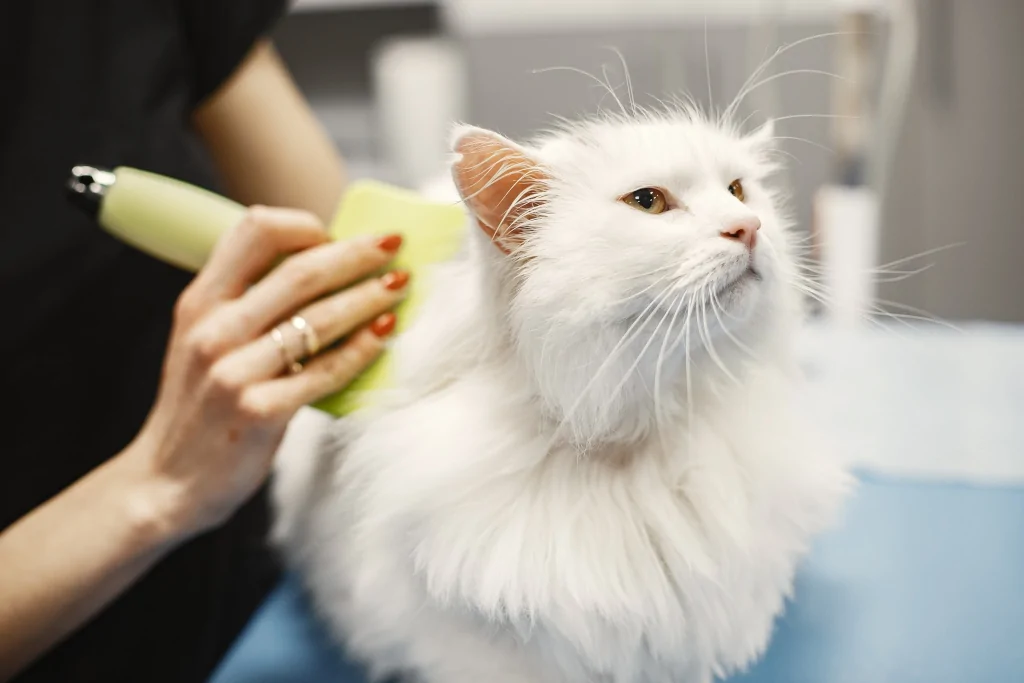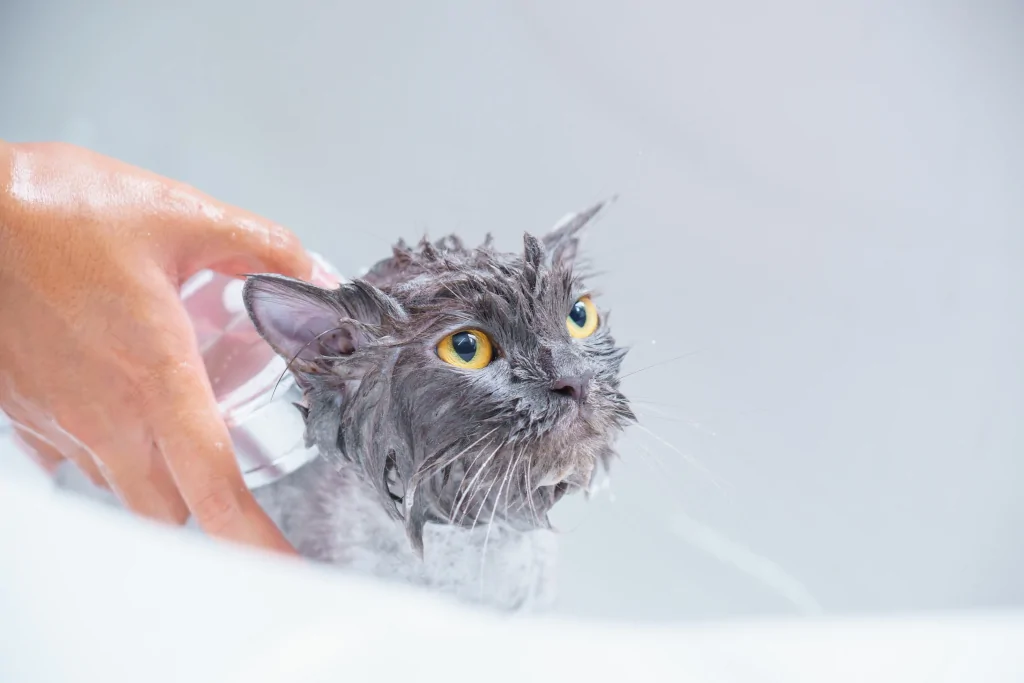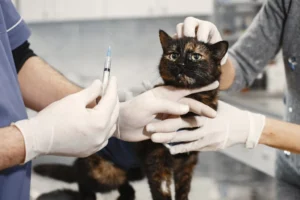Note: We may earn a commission from helpful, relevant links in our content. No cost to you. See our privacy policy.
As a loving cat owner, it can be a challenge to keep your feline friend looking and feeling their best.
Tangled fur and sharp claws might make you wonder if you’re doing enough to maintain your cat’s well-being. Fear not, for we have crafted the ultimate grooming guide to help you navigate the world of cat care.
In this comprehensive guide, you’ll find all the answers you need to keep your furball happy, healthy, and looking great.

Why Is Grooming Important for Your Cat?
Grooming is essential for your cat’s health and well-being. Regular grooming helps remove loose hair, preventing hairballs and reducing shedding around your home.
It also allows you to monitor your cat’s skin for any signs of irritation or parasites, ensuring early detection and treatment. For example, your cat may be having a dry skin and dandruff, causing them discomfort, and you wouldn’t know it if you didn’t check occassionally.
Moreover, grooming helps build trust and strengthens the bond between you and your cat, making it an essential aspect of your pet’s care routine.
Why Does Your Cat’s Coat Type Matter?
Your cat’s coat type plays a significant role in determining the proper grooming techniques and tools needed.
Different coat types, such as short-haired, long-haired, or hairless, require unique care and maintenance. For example, my short-haired cat, Smokey, only needs brushing once a week, while a long-haired cat might require daily brushing to prevent matting and tangles.
Understanding your cat’s coat type is crucial for tailoring a grooming routine that caters to their specific needs, ensuring optimal health and comfort for your feline friend.
Grooming Tools Every Cat Owner Needs
To ensure your cat’s grooming routine is effective and enjoyable, having the right tools on hand is crucial. Here’s a list of essential grooming tools that every cat owner should have:
Brushes and Combs
- Slicker brush. This brush has fine, bent bristles that help remove loose hair and gently detangle fur. It’s ideal for cats with medium to long hair but can also be used on short-haired cats. The Hertzko Self Cleaning Slicker Brush is a popular choice for its self-cleaning feature and gentle bristles
- Bristle brush. A bristle brush is perfect for short-haired cats, as it helps distribute natural oils throughout the coat, promoting a healthy shine. The Hartz Groomer’s Best Combo Brush provides a dual-sided design for versatile grooming.
- Comb. A metal comb is useful for cats with longer fur, as it helps remove tangles and prevent mats. Opt for a comb with both wide and narrow teeth for versatility. The Andis Pet Steel Grooming Comb is a durable option with both wide and narrow teeth.
Nail Care
- Nail clippers. Investing in a pair of high-quality nail clippers designed specifically for cats will make trimming your cat’s claws much easier and safer. Shiny Pet Nail Clippers are known for their sharp, precise blades and comfortable grip.
- Styptic powder. In case you accidentally cut the quick (the blood vessel in the nail) while trimming your cat’s nails, the styptic powder helps stop bleeding quickly. To avoid cutting the quick, use the right clippers, trim your cat’s nails in small increments, and use a flashlight to help visualize the quick more clearly. As a suggestion, Miracle Care Kwik Stop Styptic Powder is a trusted brand for quickly stopping bleeding.
Bathing and Ear Care
- Pet-safe shampoo. When giving your cat an occasional bath, always use a gentle, cat-specific shampoo to maintain their skin’s natural pH balance. Burt’s Bees for Cats Waterless Shampoo is a convenient, natural option for gentle cleansing.
- Ear cleaning solution and cotton balls. Regular ear cleaning is essential for your cat’s health. Choose a cat-safe ear-cleaning solution and use soft cotton balls to gently clean their ears. Zymox Ear Cleanser is a non-toxic, gentle option for regular ear cleaning.
By having these essential grooming tools at your disposal, you’ll be well-equipped to keep your cat looking and feeling their best. Happy grooming!

Mastering the Art of Brushing
Establish a Routine
The key to successful cat brushing is consistency. Set a schedule for regular brushing sessions – ideally, a few times a week.
This will not only help maintain your cat’s coat but also strengthen the bond between you and your furry friend. My cat Smokey, for example, has come to expect his brushing sessions every Sunday and Wednesday, and he even starts purring as soon as he sees the brush!
Pick the Right Brush
As mentioned earlier, it’s important to choose the right type of brush for your cat’s coat.
A slicker brush works well for medium to long-haired cats, while a bristle brush is more suitable for short-haired cats. Make sure the brush you choose is comfortable for both you and your cat.
Start Gently
When brushing your cat, always start gently and slowly to avoid causing discomfort. Focus on one area at a time, and be sure to brush in the direction of hair growth.
For long-haired cats, you may need to hold the fur close to the skin to prevent pulling while you detangle any knots or mats.
Reward and Praise
Positive reinforcement is essential for a successful brushing experience. Praise your cat during and after the session, and offer a small treat to reward their cooperation.
This will help your cat associate brushing with positive experiences, making future sessions more enjoyable for both of you.
Know When to Stop
Cats have different tolerance levels for grooming. Pay attention to your cat’s body language, and if they show signs of stress or discomfort, like hissing or swatting, it’s time to stop. You can always try again later or break the session into shorter, more manageable segments.
Be careful around using various oils as some can be healthy, but not all. In addition, overusing oils can be harmful as well.
By following these tips and being patient, you’ll soon master the art of brushing your cat, ensuring their coat stays healthy and they remain comfortable throughout the process.
Bath Time Basics

While cats are known for their meticulous grooming habits and don’t typically require regular baths, there may be times when a bath is necessary – for example, if your cat has gotten into something sticky or smelly.
Here are some basic tips to make the experience as stress-free as possible for both you and your feline friend.
Prepare the Space
Choose a quiet, enclosed area for the bath, like a bathroom or laundry room. Gather all your supplies beforehand, including a gentle cat-specific shampoo, a soft cloth or sponge, and a large towel.
You may also want to place a non-slip mat in the tub or sink to prevent your cat from slipping during the bath.
Keep It Calm
Before attempting to bathe your cat, ensure they are as calm and relaxed as possible. You can try engaging them in a play session to burn off excess energy or offering a calming treat to help ease their nerves.
I once had to bathe my cat Smokey after he rolled in some spilled maple syrup. The sweet smell might have been appealing to him, but it was a sticky mess! I made sure to play with him first and offer a calming treat, which made the whole process much smoother.
Slow and Steady
Once your cat is relaxed, gently lower them into a tub or sink filled with a few inches of lukewarm water.
Be sure to talk to your cat in a soothing tone throughout the bath, and take your time as you wet their fur, lather the shampoo, and rinse thoroughly.
Dry and Reward
After the bath, wrap your cat in a warm towel and gently dry their fur as much as possible. Don’t forget to reward them with praise and a treat for their cooperation.
And of course, give them some space and time to groom themselves and finish drying off.
Remember, bathing a cat should be a rare occurrence, but following these basic tips can help make the process less stressful for both you and your feline companion.
Nail Care 101
Maintaining your cat’s nails is an essential aspect of their overall grooming and health. Regular nail trims not only prevent damage to your furniture but also help your cat avoid painful overgrown nails that can become ingrown or infected.
Here are some tips to make nail care a breeze for you and your feline companion.
- Get the right tools. Invest in a pair of cat-specific nail clippers or a nail grinder designed for cats. These tools are specifically designed to accommodate the shape and size of a cat’s nails, making the process more comfortable for your pet. We recommend trying these Shiny Pet Nail Clippers for a comfortable trimming experience.
- Create a relaxed atmosphere. Choose a quiet, comfortable spot for nail trimming sessions. You may want to have treats on hand and offer gentle praise to make the experience more positive for your cat.
- Trim regularly. Aim to trim your cat’s nails every two to three weeks. This will help prevent overgrowth and allow you to maintain a consistent routine.
- Know where to cut. When trimming your cat’s nails, focus on the translucent, curved tip of the nail, avoiding the pink “quick” that contains blood vessels and nerves. Cutting into the quick can cause pain and bleeding.
Here’s a video with instructions on how to trim your cat’s nails safely:
Ear Cleaning Essentials
Cats are generally quite skilled at grooming themselves, but their ears might need occasional cleaning to maintain optimal health. Excess wax, debris, or dirt can lead to ear infections or other issues. Follow these steps to safely and effectively clean your cat’s ears:
- Inspect the ears. Before cleaning, examine your cat’s ears for any signs of infection or irritation, such as redness, swelling, or a foul smell. If you notice any of these symptoms, consult your veterinarian before proceeding with cleaning.
- Use the right supplies. Purchase a cat-specific ear cleaning solution from a pet store or your veterinarian. Avoid using water, alcohol, or hydrogen peroxide, as these can cause irritation or damage to your cat’s ears. Zymox Ear Cleanser for Cats is a popular option that is safe and effective.
- Gently clean the outer ear. Moisten a cotton ball or gauze pad with the ear cleaning solution and gently wipe the outer part of your cat’s ear. Do not insert anything into the ear canal, as this can cause injury or push debris further in.
- Reward and praise. After cleaning, offer your cat a treat and some praise for their cooperation. This will help make future ear-cleaning sessions more enjoyable for both of you.
By following these tips for ear cleaning, as well as those for nail care above, you can ensure your cat stays healthy, comfortable, and well-groomed.
Grooming for Special Needs Cats
Cats with special needs, such as seniors, disabled, or cats with medical conditions, may require additional care and attention when it comes to grooming.
Be patient and gentle, and consider their specific needs when choosing grooming tools and techniques. Look for tools and techniques that are gentle and less likely to cause stress, such as a grooming glove instead of a brush.
You might need to adjust the grooming routine, frequency, or even the products you use to accommodate their unique circumstances. Adjust grooming frequency based on the cat’s tolerance, and consider using hypoallergenic or fragrance-free products to avoid potential irritants.
Remember to consult with your veterinarian for guidance on how to best care for your special needs cat’s grooming requirements.
DIY or Professional Grooming: Which Is Right for Your Cat?
Whether to groom your cat at home or rely on a professional groomer largely depends on your cat’s temperament, coat type, and your own comfort and skill level.
For instance, my cat Smokey has a short coat that is easy to maintain with a simple brushing routine at home. However, if your cat has a long or thick coat, is prone to matting, or has special needs, you might find that a professional groomer can provide the necessary expertise and specialized care.
The key is to assess your cat’s individual needs and your ability to provide a stress-free grooming experience.
If your cat is highly anxious, uncooperative, or has special grooming needs that you’re not comfortable handling, it may be best to seek the expertise of a professional groomer.
The Finishing Touch: A Purr-fectly Groomed Cat
To wrap up, proper cat grooming plays a vital role in your feline friend’s overall health and happiness. By following the tips and tricks in this guide, you’ll be well on your way to mastering the art of cat grooming tailored to your pet’s unique needs.
Don’t forget to explore our other cat-centric guides on vet visits, essential enrichment, and skin and coat care to keep your kitty purring with delight.
FAQs
How do I know if my cat is enjoying the grooming process?
To determine if your cat is enjoying the grooming process, observe their body language. A relaxed and content cat will have a calm demeanor, purr, or lean into the grooming strokes.
Can I use human grooming products on my cat?
We do not recommend (nor is it generally recommended) using human grooming products on your cat, as they may contain ingredients that are harmful or irritating to your cat’s skin. Always use products specifically formulated for cats.
What can I do if my cat is afraid of grooming tools?
If your cat is afraid of grooming tools, try introducing them slowly and with positive reinforcement, like treats and praise. You can also try using alternative tools that are less intimidating, such as a grooming glove.
How can I prevent hairballs in my cat through grooming?
To prevent hairballs in your cat through grooming, brush your cat regularly to remove loose fur, reducing the amount they ingest while self-grooming. Additionally, consider providing a hairball-control diet or supplement, as recommended by your veterinarian.
Alex, a passionate animal lover, has experience in training and understanding animal behavior. As a proud pet parent to two dogs and three cats, he founded AnimalReport.net to share insights from animal experts and expand his knowledge of the animal kingdom.









